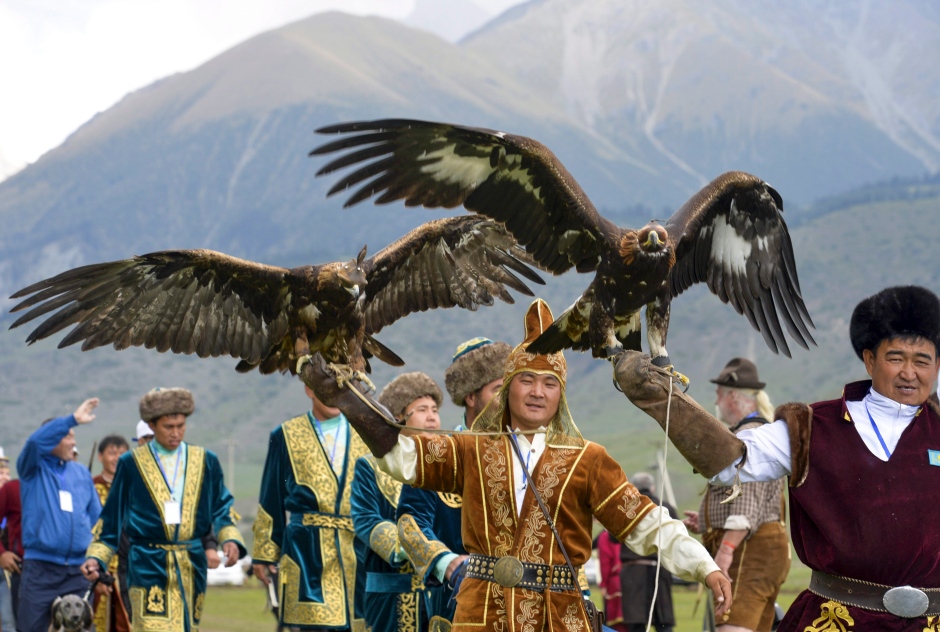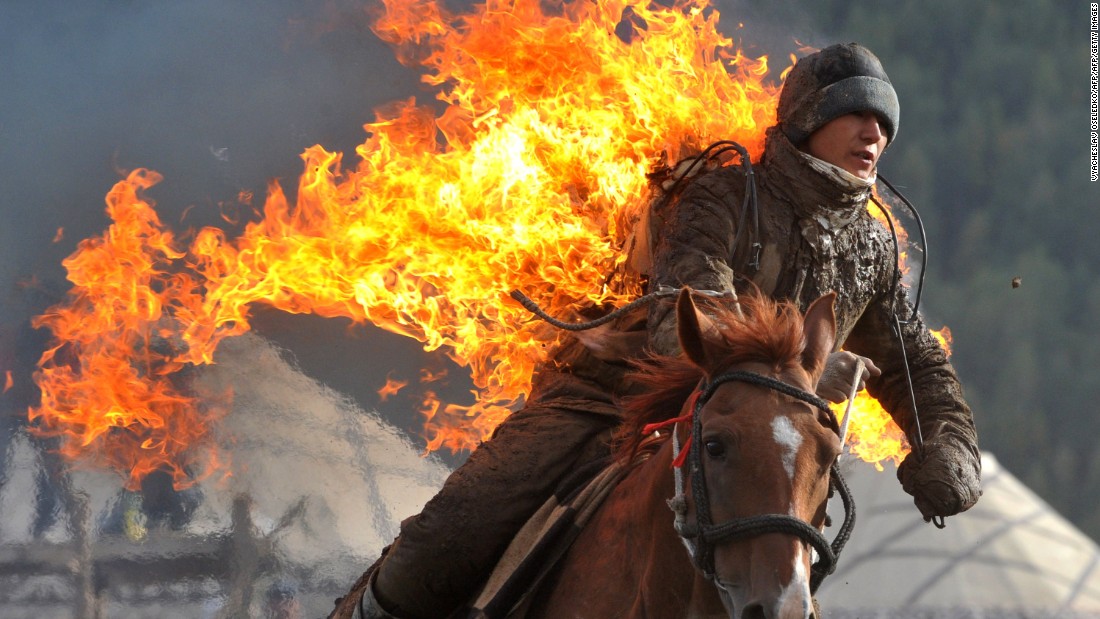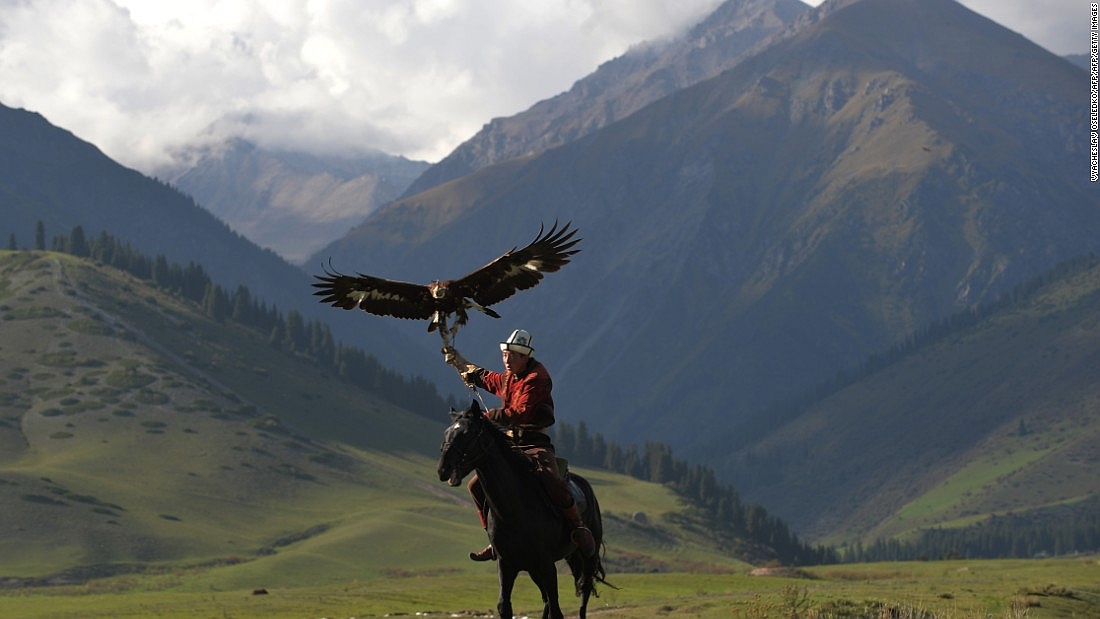

Nomads kick ass! James Dator explains:
The World Nomad Games concluded on Friday in what can only be described as the greatest week-long sporting event on the planet. The games, intended to showcase ethnic sports of Central Asia, featured things you have never heard of, athletes you'll never learn about and sports that sound absolutely terrifying.James Dator explains more games here:There were 16 sports with medals up for grabs. These are the ones that are the absolute wildest.
Cirit
This Turkish equestrian sport involves teams of riders chasing each other and throwing javelins at each other while on horseback. Yes, seriously.Er Enish
It's wrestling, except you're on a horse. You win by pulling your opponent off their horse.Kok-boru
There's no delicate way to explain Kok-boru. It's horseback basketball using a goat carcass. You win by tossing the dead goat into your opponent's well. It comes from a tradition of beating up wolves that attacked your herd of sheep and throwing a dead wolf to your friends who went wolf hunting with you.Mas-wrestling
In this form a wrestling, athletes fight over a stick. Each wrestler is given part of the stick to hold and are seated facing each other with their feet on a plank. Whoever gets the stick wins.Salbuurun
A three-step hunting sport involving animals. Competitions are held in the following disciplines:
- Burkut saluu - hunting with golden eagles. Composition of the team - 6 people: 1 leader and 5 berkutchi (hunter with eagles).

- Dalba oynotuu - falcon flying to the lure. Composition of the team - 6 people: 1 leader and 5 Kushchu (falconer).
- Taigan jarysh - dog racing among breeds of greyhound. Composition of the team - 6 people: 1 leader and 5 owners of dogs.

There's more here:


Here Canadian photographer David Burdeny captured an iceberg rising straight out of the ocean. It seems to divide the world into four parts.
He took this photo in 2007 in the Weddell Sea, one of the two big dents in Antarctica separated by the huge peninsula called West Antarctica. Scientists have found that the Weddell Sea has the clearest water of any sea. But it's a dangerous place, according to historian Thomas R. Henry's book White Continent:
The Weddell Sea is, according to the testimony of all who have sailed through its berg-filled waters, the most treacherous and dismal region on earth. The Ross Sea is relatively peaceful, predictable, and safe.The Ross Sea is the other big dent in Antarctica:
David Burdeny took this photo in 2007 and called it 'Mercator's Projection'. It appeared as part of a series of photos from Antarctica and Greenland. As a fan of the Earth's desolate regions, I like these a lot:
About 400 light years away, there's something with rings like Saturn — but much, much bigger!
It's called J1407b. It could be a huge planet. Or it could be a star so small that it never lit up: a brown dwarf.
One of Saturn's largest visible rings, the F ring, is about 140 thousand kilometers in radius. But J1407b's rings are almost a thousand times bigger. It has rings 90 million kilometers in radius!
That's 2/3 as big as the Earth's orbit around the Sun. That's insane! It's so huge that scientists don't know why the ring doesn't get ripped apart by the gravity of the star it orbits.
One theory is that the rings are spinning in a retrograde way — in other words, backwards. If you have a planet moving clockwise around a star, and its rings are turning counterclockwise, this helps keep them from getting pulled apart. You can see a simulation here:
However, it's not obvious why the rings would turn backwards.
There's no sharp boundary between a very large planet and a very small star. If it produces heat using nuclear fusion, it's considered a star... but there are some funny borderline cases.
Stars about 13 times heavier than Jupiter get hot enough to fuse deuterium — but they quickly fizzle out, since that isotope of hydrogen is rare. Stars about 65 times heavier than Jupiter can also fuse lithium... but then fizzle out. So, these things are called brown dwarfs. Stars over 80 times heavier than Jupiter can actually fuse hydrogen, so they light up and form very small red dwarfs.
The atmosphere of a hot brown dwarf is similar to a sunspot — a cold spot on our Sun. It contains molecular hydrogen, carbon monoxide and water vapor. This is called a class M brown dwarf.
But after they run out of fuel, they cool down. The cooler class L brown dwarfs have clouds!
But the even more chilly class T brown dwarfs do not. Why not?
Here's a popular theory: the clouds may rain down, with material moving deeper into the star! People seem to be seeing this in Luhman 16B, a brown dwarf 7 light years from us. It's half covered by huge clouds. These clouds are hot — 1200 °C — so they're probably made of sand, iron or salts. But some of them have been seen to disappear!
Finally, as brown dwarfs cool below 300 °C, astronomers expect that ice clouds start to form: first water ice, and eventually ammonia ice. These are called class Y brown dwarfs.
Wouldn't that be neat to see? A star with icy clouds! And maybe it could have huge rings, too!
For more on J1407b, try Wikipedia:
The picture above is an artist's impression by Ron Miller.
October 14, 2016
Chariklo orbits the Sun between Saturn and Uranus. Just 250 kilometers across, it has two tiny rings!
Is it an asteroid? Not quite: it's a 'centaur'. In Greek mythology, a centaur was half-human, half-horse. In astronomy, a centaur is halfway between an asteroid and a comet. Centaurs live in the outer solar system between Jupiter and Neptune. They don't stay there long - at most a million years. They come from further out, pulled in by the gravity of Neptune, but their orbits are chaotic and they eventually move in toward Jupiter.
Over 300 centaurs have been seen, and scientists believe there are over 40,000 that are bigger than a kilometer across. But Chariklo is the biggest. And it has two rings!
In my last entry I discussed a 'super Saturn' — an object in another solar system with rings almost a thousand times bigger than Saturn. Chariklo, on the other hand, is a 'mini Saturn'. Its rings are just 800 kilometers across — just 0.3% the size of Saturn's F ring.
These rings are narrow and dense. One is about 6 kilometers wide and the other — which you can barely see in this artist's picture — is just 3 kilometers wide. They're separated by a 9-kilometer gap.
How did they get there? Some smaller objects—probably made of ice—may have collided and broken apart. But they must have collided not too fast, or they would have shot all over instead of forming neat rings.
The rings are probably not very stable, unless Chariklo has one or more moons to stabilize them. Saturn has such moons, called shepherd moons.
The second largest centaur, called Chiron, may also have rings.
Puzzle 1. Who was Chariklo in Greek mythology?
Puzzle 2. Who was Chiron?
For answers, see the comments on my G+ post.
Chariklo's full name is 10199 Chariklo:
Its rings are tentatively named Oiapoque and Chuí, after two rivers in Brazil:
Centaurs are lots of fun if you like celestial mechanics:
I can't resist quoting a bit:
Because the centaurs are not protected by orbital resonances, their orbits are unstable within a timescale of 106 to 107 years. For example, 55576 Amycus is in an unstable orbit near the 3:4 resonance of Uranus. Dynamical studies of their orbits indicate that being a centaur is probably an intermediate orbital state of objects transitioning from the Kuiper belt to the Jupiter family of short-period comets. Objects may be perturbed from the Kuiper belt, whereupon they become Neptune-crossing and interact gravitationally with that planet. They then become classed as centaurs, but their orbits are chaotic, evolving relatively rapidly as the centaur makes repeated close approaches to one or more of the outer planets. Some centaurs will evolve into Jupiter-crossing orbits whereupon their perihelia may become reduced into the inner Solar System and they may be reclassified as active comets in the Jupiter family if they display cometary activity. Centaurs will thus ultimately collide with the Sun or a planet or else they may be ejected into interstellar space after a close approach to one of the planets, particularly Jupiter.The picture here was created by Nick Risinger for ESO, the European Southern Observatory in Chile. They reported their discovery here:
That's what it looks like to me. But it's an image created by Greg Egan, the science fiction author. And there's a story behind it.
Egan and I figured out a bunch of stuff about the 'McGee graph', a highly symmetrical graph with 24 vertices and 36 edges. I wrote an article about it on Visual Insight, my blog for beautiful math pictures. Later I got an email from Ed Pegg, Jr. saying he'd worked out a 'unit-distance embedding' of the McGee graph: a way of drawing it in the plane so that any two vertices connected by an edge are distance 1 apart. He wanted to know if this was 'rigid' or 'flexible'. In other words, he wanted to know whether you can change its shape slightly while it remains a unit-distance embedding.
Egan thought about it a lot and did a lot of computations and discovered that this unit-distance embedding is flexible. And here it is, flexing!
For Pegg and Egan's work, go here:
Puzzle 1. With a minimum of explicit computation, prove that any unit-distance embedding of the McGee graph is infinitesimally flexible.
Infinitesimal flexibility is a necessary but not sufficient condition for true flexibility.
Puzzle 2. Find a unit-distance embedding of a graph that is infinitesimally flexible but not flexible.
So, Egan had to do more work to show Pegg's unit-distance embedding of the McGee graph was actually flexible. There is probably a high-powered theoretical way to do this, and it's probably not even very complicated, but I don't know it. Do you?
For discussions of the puzzles, look at the comments on my G+ post. For my Visual Insight post on the McGee graph, go here:
Here, by the way, is Greg Egan's answer to Puzzle 1: